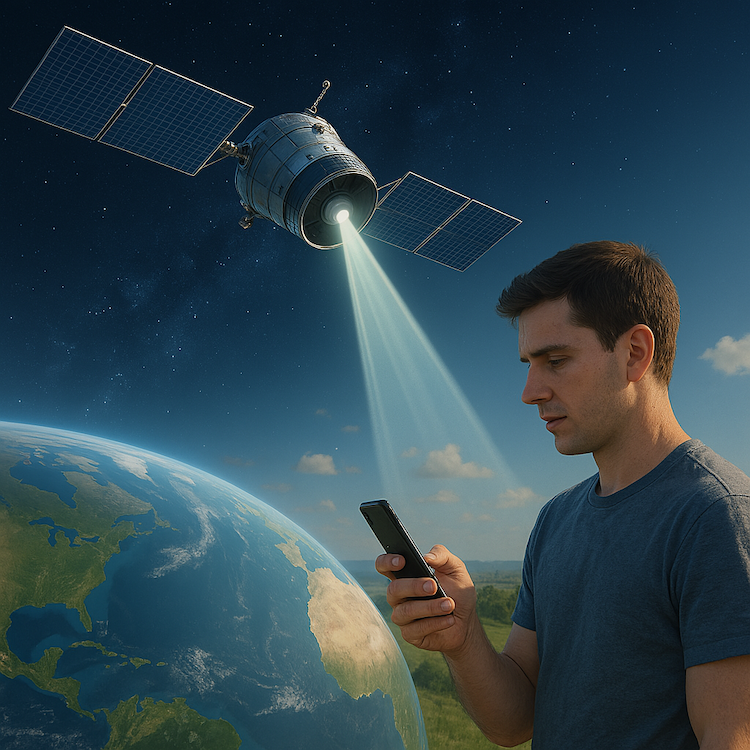The world of communication is evolving rapidly, and one of the most exciting developments in recent years is satellite-to-mobile technology. This innovation enables direct communication between satellites in orbit and standard smartphones on the ground—no traditional cell towers required. Major players like SpaceX, AST SpaceMobile, and Lynk Global are racing to bring global satellite-to-mobile services to market, promising connectivity in the most remote parts of the world. But while the technology is groundbreaking, it also comes with a complex set of challenges.
Let’s dive into the major benefits and potential drawbacks of satellite-to-mobile communication to better understand its impact on users, service providers, and the future of global connectivity.
Pros of Satellite-to-Mobile Technology
1. Global Coverage
Perhaps the biggest advantage is the ability to provide coverage almost anywhere on Earth. Traditional cell towers cover only about 15-20% of the planet’s surface. Satellite-to-mobile connections could extend service to remote islands, deserts, oceans, and mountain ranges—areas that are currently digital black holes. This could be life-changing for people living or traveling in underserved or off-grid areas.
2. Enhanced Emergency Communication
In emergencies, especially natural disasters like hurricanes or earthquakes, terrestrial infrastructure like cell towers often gets damaged or goes offline. Satellite communication doesn’t rely on ground infrastructure, making it a more resilient option for emergency services and disaster response. Even if the grid is down, users may still be able to send messages or make emergency calls via satellite.
3. No Specialized Hardware Needed
Unlike traditional satellite phones, emerging satellite-to-mobile technology aims to work with standard smartphones. Apple has already incorporated emergency SOS via satellite in its newer iPhone models, and other manufacturers are following suit. This opens up satellite connectivity to a massive audience without requiring them to invest in dedicated devices.
4. Potential for Competitive Pricing
With more players entering the market and advances in satellite miniaturization and deployment (especially with low Earth orbit, or LEO, satellites), the cost of satellite communication is dropping. In the future, users might enjoy affordable or even bundled satellite service as part of their regular mobile plan, especially in rural areas where traditional infrastructure costs remain high.
5. Boost to IoT and Remote Industries
Industries like agriculture, shipping, mining, and oil and gas often operate in areas with limited connectivity. Satellite-to-mobile technology can improve machine-to-machine communication and real-time data transfer in these remote locations, enhancing productivity, safety, and decision-making.
Cons of Satellite-to-Mobile Technology
1. Limited Bandwidth and Speed
One of the biggest hurdles is bandwidth. Satellite connections—especially those relayed via small satellites in LEO Low Earth Orbit—have limited capacity. This means data speeds may be slower than traditional 4G or 5G networks. In its current form, satellite-to-mobile is best suited for low-bandwidth uses like SMS, emergency calls, or basic internet browsing.
2. Latency Issues
Even with LEO satellites, which orbit closer to Earth than traditional satellites, latency remains higher than with ground-based networks. This can affect real-time applications like video calls or gaming. While improvements are ongoing, latency could remain a sticking point for performance-intensive uses.
3. High Deployment and Maintenance Costs
Launching satellites into orbit is expensive. Even with reusable rockets and economies of scale, building and maintaining a global constellation of satellites is a costly endeavor. These expenses may be passed on to consumers, at least initially, in the form of higher prices or subscription tiers for satellite access.
4. Regulatory and Spectrum Challenges
Satellite operators must navigate complex international regulations and secure licenses to operate in different countries. There’s also competition for radio frequency spectrum, with concerns about interference between terrestrial mobile networks and satellite signals. This could delay rollouts or limit service availability in certain regions.
5. Environmental and Space Debris Concerns
The rapid increase in satellite launches raises environmental questions. Satellites contribute to light pollution and space debris, which could threaten other satellites, spacecraft, and even the long-term sustainability of orbital operations. Companies must take responsibility for satellite end-of-life management to avoid worsening the problem.
6. Uneven User Experience
While some users might get great service in remote areas, others—especially in urban environments surrounded by tall buildings—might struggle to establish a clear line of sight to the satellite. Weather can also affect satellite signals, especially during storms or heavy cloud cover, potentially leading to unreliable performance.
Looking Ahead
Satellite-to-mobile technology represents a bold leap toward global connectivity, especially for those currently underserved by traditional networks. As technology matures and more satellites are deployed, we can expect better speed, lower latency, and more widespread coverage.
Still, it’s not a silver bullet. Challenges related to cost, performance, and environmental impact will need careful attention. Most experts agree that satellite connectivity will complement, not replace, terrestrial mobile networks—especially in urban and suburban areas where fiber and 5G are already strong.
For the everyday consumer, this means a future where losing signal on a hiking trail, out at sea, or during a natural disaster might no longer mean being cut off from the world. It’s an exciting time for connectivity, and satellite-to-mobile is set to play a vital role in bridging the global digital divide.



